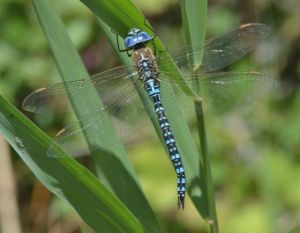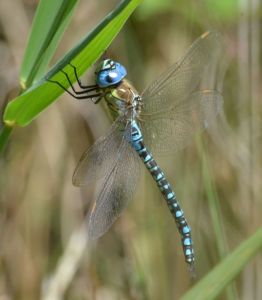Until recently classed as a rare migrant from mainland Europe, the Blue-eyed or Southern Migrant Hawker dragonfly has in the last few years colonised sites along the Thames estuary in Essex. Large numbers of odo enthusiasts have visited Basildon Borough Council’s Wat Tyler Country Park to see them in that time, and when reports appeared on the BDS web site again this year I decided to give it a go.
At the Wat Tyler Centre I met education officer Neil Phillips who has been responsible for releasing information on this rarity (see here). He directed me to the exact location where the SMH are being seen and one other observer was there already. Before long two male SMH appeared, one of which commenced to fly around our heads and hover in front of our faces. The species has a stronger blue colouration than the frequently seen Migrant Hawker, with no yellow markings. The males’ vivid blue eyes and largely green sides to the thorax stand out, suggesting an Emperor dragonfly in miniature.
It was a slightly surreal experience that an insect I had travelled 90 miles to see appeared to be taking a good look at me. SMH favours almost dried out pools that are choked with bulrushes and conditions here are perfect for them. When this individual settled he revealed a distinct kink in the lower abdomen that would have been caused during emergence. Late morning is the peak time for sightings apparently, and more observers duly arrived.

“The sky is calling, the wind is at my shoulders, mama I’m bent to fly.” (Lyric © S Hudson / M Kennedy)
As a site WTCP has the ambience of a public park rather than a nature reserve. When a guided tour party turned up at 11am I displayed remarkable tolerance in helping to ensure that all the children picked out the pretty blue dragonfly. There’s hope for me yet! It would have been good to see a straight SMH but things were a bit crowded here for my liking and I didn’t linger.
There are various other marshland nature reserves along this stretch of the Thames estuary. Upon enquiry I found that the RSPB’s neighbouring Bowers Marsh (TQ755867) is a site for Scarce Emerald damselfly. In the afternoon I did a reconnoitre there, seeing two Emerald types but not well enough to PI them. But I now know a location for the only regular English damselfly I have yet to observe, and expect to be back. The SMH fly throughout August.


